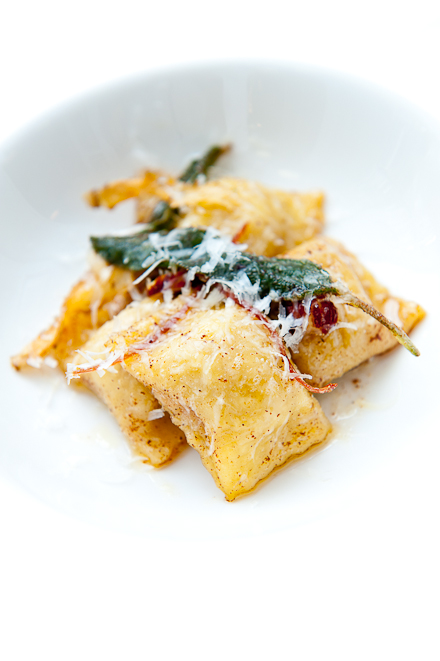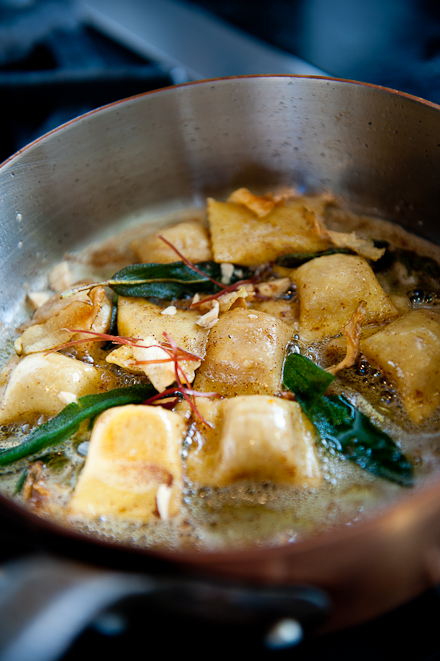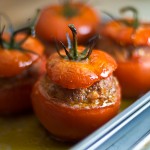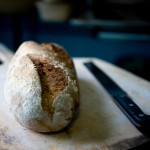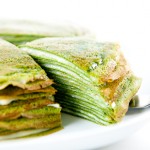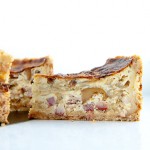Butternut Squash Agnolotti w/ Brown Butter, Sage & Pecorino
With temperatures cooling and days getting shorter, the fall season is upon us. People are enjoying the crisp days of autumn but also spending more time in the warmth of the kitchen. With all this coziness in the air one might be inclined to procrastinate but I remembered what Master Yoda once said: “brush up on your pasta skills, you will”. So I dragged my butt to the kitchen for a little practice. I think making agnolotti from scratch is a nice little week-end project you might enjoy too.
Agnolotti is a type of ravioli typical of the Piedmont region of Italy but with a better, clever design. The pasta sheet is folded twice over the meat or vegetable stuffing and pinched to create little pillows with the perfect ratio of pasta to stuffing and a built-in flap to catch the sauce. Genius! It is also found in smaller size, when it is called Agnolotti al Plin. ‘Plin’ means a ‘pinch’ in the local dialect. Whoever invented this folding technique deserves the Nobel prize of… pasta.
I made this recipe with a butternut squash filling but you could easily substitute it with sweet potatoes. Those two. They’re interchangeable here. Just roast them to concentrate the sweet, earthy flavors that makes them extra special. We could go with a more complex sauce but what work best here, in my opinion, is a brown butter with sage, and grated pecorino. A julienne of proscuitto and some crushed toasted hazelnut to add a little intrigue and you’re good to go.
-
Butternut Squash Agnolotti w/ Brown Butter, Sage & Pecorino
-
- Serves 4
-
-
Pasta dough for agnolotti (adapted from The French Laundry cookbook):
- 1 3/4 cups (8 ounces) all-purpose flour
- 6 large egg yolks
- 1 large egg
- 1 1/2 teaspoons olive oil
- 1 tablespoon milk
-
For the butternut squash filling:
- 1 large butternut squash (about 3 lbs)
- 1 large egg
- 3 tablespoons butter
- 2 tablespoons heavy cream
- 8 sage leaves
- 3 tablespoons freshly grated Pecorino or Parmegiano
- salt & black pepper to taste
-
For the sage brown-butter and finish:
- 6 tablespoons butter
- 10 sage leaves
- Pecorino for grating
- 4 slices proscuitto, julienned
- 1/4 cup toasted hazelnut, crushed
- salt and pepper, to taste
-
Pasta dough for agnolotti:
- Mound the flour on a board or other surface and create a well in the center. Pour the egg yolks, egg, oil, and milk into the well. Use your fingers to break the eggs up and, in a circular motion, keep working them into the flour. Using a pastry scraper, occasionally push the flour toward the eggs. When the dough is thick and starts lifting itself from the board, incorporate the remaining flour with the pastry scraper. Bring the dough together with the palms of your hands and form it into a ball.
- Knead the dough by pressing it, bit by bit, in a forward motion with the heels of your hands rather than folding it over on itself as you would with a bread dough. Re-form the dough into a ball and repeat the process several times. The dough should feel moist but not sticky.
- Dust the clean work surface with a little flour. Knead the dough by pushing against it in a forward motion with the heels of your hands. Form the dough into a ball again and knead it again. Keep kneading in this forward motion until the dough becomes silky-smooth. The dough is ready when you can pull your finger through it and the dough wants to snap back into place. The kneading process can take anywhere from 10 to 15 minutes. Even if you think you are finished kneading, knead it for an extra ten minutes; you cannot over knead this dough.
- Double-wrap the dough in plastic wrap to ensure that it does not dry out. Let the dough rest for at least 30 minutes and up to 1 hour before rolling it through a pasta machine. The dough can be made a day ahead, wrapped and refrigerated; bring to room temperature before proceeding.
-
-
For the butternut squash filling:
- Preheat the oven to 375′F. Cut the butternut squash in half, scoop out the seeds and season generously with salt and black pepper. Lay on a baking tray (cut side up) and bake for about 1 1/2 hour, or until very soft. When the squash is ready, discard the water that has accumulated in the cavity and scoop out the meat and place in the bowl of a food processor. Discard the skin. Add the egg to the squash in the food processor. In a small saucepan cook the butter until it turns golden brown (beurre noisette) and quickly add the sage leaves and the heavy cream, boil for 1 minute and pour the hot mixture on top of the squash and the egg. Add the Parmigiano-Reggiano and process until smooth. Add salt and pepper to taste. Cool the mixture and refrigerate until ready to use. Place the filling in a pastry bag with a 1/2-inch round tip (or a ziploc bag in which you cut a 1/2 inch corner opening
-
Roll, fill and shape the agnolotti:
- To form sheets for agnolotti: Use the pasta dough, divided into four or five pieces. Run the dough through a pasta machine as for ravioli, but make the sheets wider. The size will vary according to the pasta machine used, but the sheets should be at least five inches wide. It is important that your pasta sheet be thin enough so that you can see your fingers through it, but not so thin that it’s translucent. Keep the pasta sheets covered, as they dry out quickly, and proceed with filling the agnolotti.
- To fill agnolotti: If you are planning on using the agnolotti immediately, have a large pot of lightly salted boiling water ready. Work with one sheet of pasta at a time, keeping the remaining sheets covered. Work quickly, as fresh pasta will dry out.
- Lay the pasta sheet on a lightly floured surface with a long side facing you. Trim the edges so they are straight. Place the agnolotti filling in a pastry bag fitted with a 1/2-inch plain tip. Pipe a “tube” of filling across the bottom of the pasta sheet, leaving a 3/4-inch border of pasta along the left, right and bottom edges.
- Pull the bottom edge of the pasta up and over the filling. Seal the agnolotti by carefully molding the pasta over the filling and pressing lightly with your index finger to seal the edge of the dough to the pasta sheet. When it is sealed, there should be about 1/2 inch of excess dough visible along the tube of filling (where you sealed it). Be certain that you are sealing tightly while pressing out any pockets of air. Seal the left and right ends of the dough.
- To shape agnolotti: Starting at one end, place the thumb and forefinger of each hand together as if you were going to pinch something and, leaving about 1 inch of space between your hands and holding your fingers vertically, pinch the filling in 1-inch increments, making about 3/4 inch of “pinched” are between each pocket of filling. It is important to leave this much “pinched” area between the agnolotti, or when the agnolotti are separated, they may come unsealed.
- Run a crimped pastry wheel along the top edge of the folded-over dough, separating the strip of filled pockets from the remainder of the pasta sheet. Don’t cut too close to the filling, or you risk breaking the seal. Separate the individual agnolotti by cutting the center of each pinched area, rolling the pastry wheel away from you. Working quickly, place the agnolotti on a baking sheet dusted with a thin layer of cornmeal, which will help prevent sticking. Repeat the same procedure on the remainder of your pasta sheets. Either cook the agnolotti immediately in the boiling water, or place the baking sheet in the freezer. Once the agnolotti are frozen, place them in airtight freezer bags and keep them frozen for up to several weeks. Cook the agnolotti while still frozen.
-
Cook the agnolotti and finish:
- Bring a large pot of salted water to a boil. Add the agnolotti to the water and cook for 4 to 5 minutes.
- Melt the butter in large pan and make a light-colored brown butter. Add the sage and continue cooking for 15 more seconds. Grind some fresh black pepper in the sage-brown butter and set aside. Remove the agnolotti from the pot with a spider or slotted spoon (they should be floating at the surface at this point) and add to the sage brown-butter along with 3 tablespoons of the pasta water. Coat the sauce evenly over the agnolotti. The starchy pasta water will help bind the sauce. Plate the agnolotti among four bowls. Top with julienned proscuitto and crushed hazelnuts. Grate some Pecorino over each portion and serve immediately.



